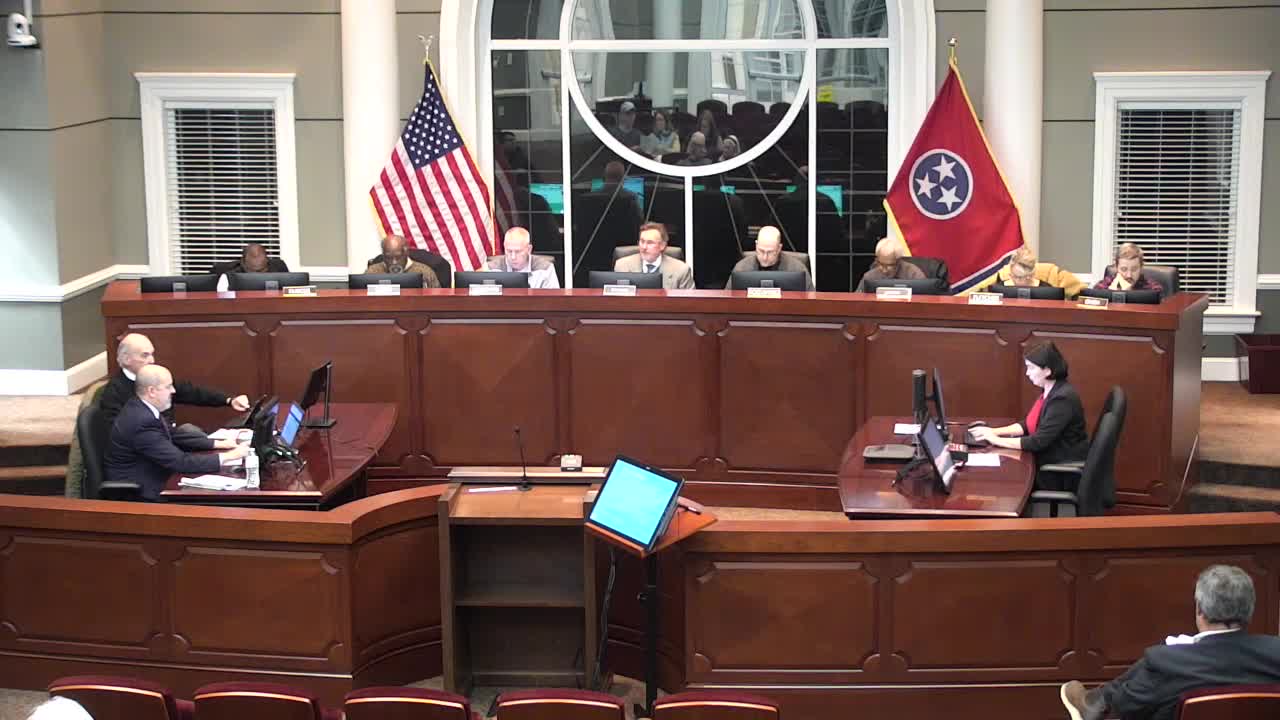Collierville planning panel backs rezoning of former landfill tract to limit future development
January 07, 2025 | Collierville, Shelby County, Tennessee
This article was created by AI summarizing key points discussed. AI makes mistakes, so for full details and context, please refer to the video of the full meeting. Please report any errors so we can fix them. Report an error »

The Collierville Planning Commission voted to recommend approval of Ordinance 2025‑02 to rezone a two‑tract property owned by Blalock and Brown Construction Inc. from R‑1 (low‑density residential) to FAR (Forest Agricultural Residential).
Jamie Gross, Collierville planning staff, told the commission the town initiated the rezoning because the property includes a Class 3 landfill that ceased operations in 2022 and is now being closed and capped by the Tennessee Department of Environment and Conservation (TDEC). Gross said the town is concerned the parcel could be auctioned and bought “sight unseen,” leading purchasers to overestimate its development potential.
The proposed change reduces the theoretical residential density on the tract: FAR’s minimum lot size is roughly 5 acres while R‑1’s entitlement allows lots as small as about 15,000 square feet. Gross said the Collierville 2040 plan’s maximum gross residential density map marks much of the site as “clear” (no dwelling units expected) because of the landfill mound, floodplain, former gravel pits and organic soils that complicate foundations and utilities.
Lou Wardlaw of Martin, Tate, Morrow & Marston, representing Blalock and Brown Construction Inc., opposed the rezoning. Wardlaw said the change would “decrease the use by upwards of 7 fold” and argued rezoning to prevent hypothetical future misuse was an improper use of zoning authority. He asked the commission to recommend a “no” vote to the Board of Mayor and Aldermen.
Residents who live near the property told commissioners they supported the town’s proposal. Sandy Hanson of Halley Plantation asked whether the town had an update on a separate lake‑stabilization/dredging project near her neighborhood; commissioners referred the resident to staff for follow‑up. Other neighbors described historical odors and gravel‑pit conditions and said those circumstances supported caution about new dense development.
Commissioners who spoke during the hearing cited the site’s physical and regulatory constraints—the capped landfill, floodplain, organic soils, limited road frontage and sewer capacity—and said FAR zoning reduces the chance a future buyer will assume the property supports conventional suburban subdivisions.
After discussion, a motion to recommend approval of Ordinance 2025‑02 was made and seconded. Angela called the roll and the commission recorded unanimous affirmative votes from Commissioners DeBose, Green, Goddard, Jordan, Rosansky, Fletcher, Gibbon and Cotton. The recommendation goes to the Board of Mayor and Aldermen; staff said the ordinance will have three readings and that the second reading will include a public hearing tentatively scheduled for Feb. 10.
The commission’s recommendation does not itself change zoning; any final change would occur if and when the Board of Mayor and Aldermen adopts the ordinance in subsequent readings. Gross reminded the public that no development application for the site is pending and that any future site plan would require soils analysis, building‑permit review and possible easement or deed restrictions tied to TDEC closure requirements.
Jamie Gross, Collierville planning staff, told the commission the town initiated the rezoning because the property includes a Class 3 landfill that ceased operations in 2022 and is now being closed and capped by the Tennessee Department of Environment and Conservation (TDEC). Gross said the town is concerned the parcel could be auctioned and bought “sight unseen,” leading purchasers to overestimate its development potential.
The proposed change reduces the theoretical residential density on the tract: FAR’s minimum lot size is roughly 5 acres while R‑1’s entitlement allows lots as small as about 15,000 square feet. Gross said the Collierville 2040 plan’s maximum gross residential density map marks much of the site as “clear” (no dwelling units expected) because of the landfill mound, floodplain, former gravel pits and organic soils that complicate foundations and utilities.
Lou Wardlaw of Martin, Tate, Morrow & Marston, representing Blalock and Brown Construction Inc., opposed the rezoning. Wardlaw said the change would “decrease the use by upwards of 7 fold” and argued rezoning to prevent hypothetical future misuse was an improper use of zoning authority. He asked the commission to recommend a “no” vote to the Board of Mayor and Aldermen.
Residents who live near the property told commissioners they supported the town’s proposal. Sandy Hanson of Halley Plantation asked whether the town had an update on a separate lake‑stabilization/dredging project near her neighborhood; commissioners referred the resident to staff for follow‑up. Other neighbors described historical odors and gravel‑pit conditions and said those circumstances supported caution about new dense development.
Commissioners who spoke during the hearing cited the site’s physical and regulatory constraints—the capped landfill, floodplain, organic soils, limited road frontage and sewer capacity—and said FAR zoning reduces the chance a future buyer will assume the property supports conventional suburban subdivisions.
After discussion, a motion to recommend approval of Ordinance 2025‑02 was made and seconded. Angela called the roll and the commission recorded unanimous affirmative votes from Commissioners DeBose, Green, Goddard, Jordan, Rosansky, Fletcher, Gibbon and Cotton. The recommendation goes to the Board of Mayor and Aldermen; staff said the ordinance will have three readings and that the second reading will include a public hearing tentatively scheduled for Feb. 10.
The commission’s recommendation does not itself change zoning; any final change would occur if and when the Board of Mayor and Aldermen adopts the ordinance in subsequent readings. Gross reminded the public that no development application for the site is pending and that any future site plan would require soils analysis, building‑permit review and possible easement or deed restrictions tied to TDEC closure requirements.
View full meeting
This article is based on a recent meeting—watch the full video and explore the complete transcript for deeper insights into the discussion.
View full meeting
